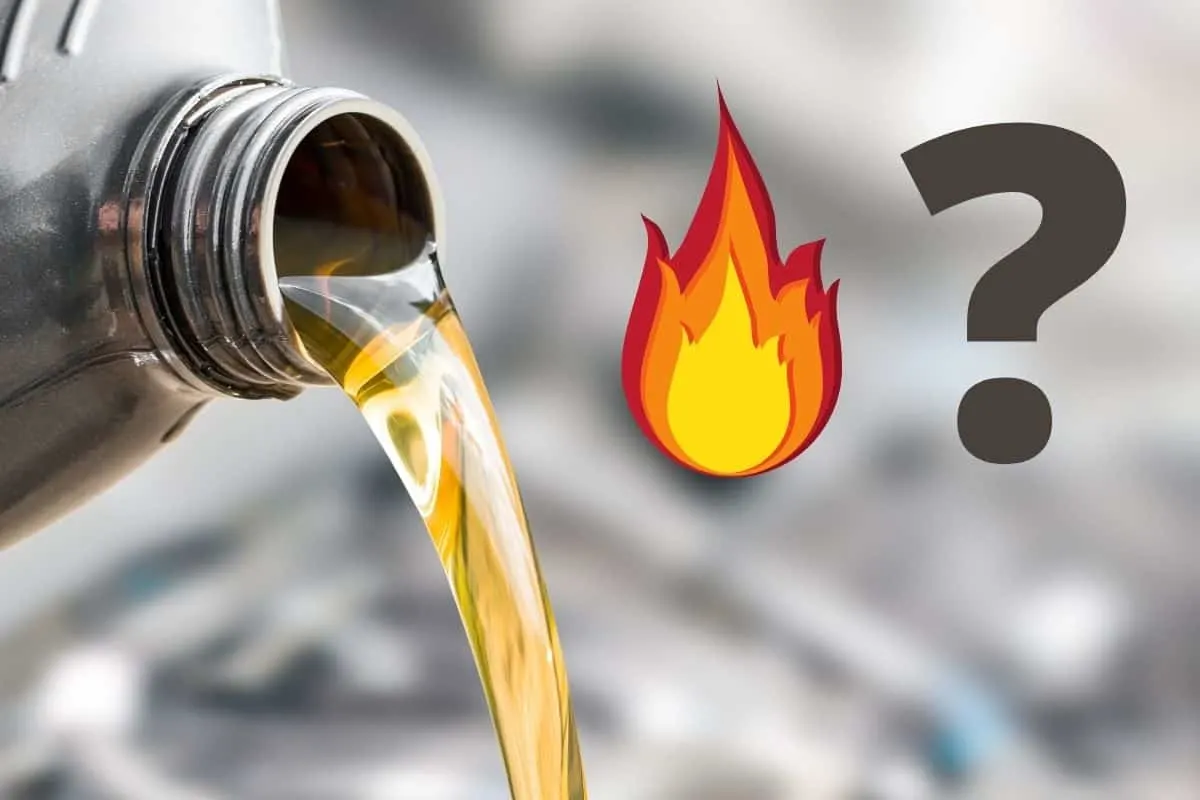Engine oil prevents and protects engine components and lubricates the engine, preventing its inevitable wear and tear. However, due to its combustible nature, you may find yourself wondering if motor oil is flammable, and how you should store it safely!
Motor oil is classified as a combustible rather than flammable liquid. It has a flashpoint of 419 degrees Fahrenheit (215 degrees Celsius), which is above the auto industry’s 199.4 degrees Fahrenheit (93 degrees Celsius) threshold for flammable liquids.
Combustible materials burn in the presence of air, but flammable materials quickly ignite when exposed to fire. With high enough temperatures, motor oil can catch burn, so let’s take a look at this in more detail.
Is Used Motor Oil Flammable?
If you’re wondering if used motor oil is more flammable, then the quick answer is no.
Typically, oxidation causes oil to soften and lose its viscosity, allowing it to mix with gasoline more easily. But even in a highly oxidized state, the oil will not ignite easily when exposed to flame due to its high flashpoint.
The flashpoint refers to the temperature at which there are adequate fumes released enough to ignite. Due to the high flashpoint, motor oil needs a high temperature to burn.
Motor oil is a mixture of hydrocarbons with longer molecule chains, making it a heavier liquid. It requires more energy or higher temperatures to vaporize. It does catch fire but at much higher temperatures that exceed the flashpoint temperature.
When considering the flammability of a liquid, the primary determinant is the ability to produce vapor to ignite automatically. The majority of flammable liquids have short-chained hydrocarbons.
The short molecules quickly vaporize and therefore ignite at lower temperatures.

Is Synthetic Oil Flammable?
Synthetic oil is flammable due to the presence of hydrocarbon elements. However, its flash point is high as its design functions at very high temperatures without igniting or disintegrating.
Generally, the rate of combustion for synthetic oil is lower than regular motor oil, as it requires higher temperatures for ignition.
Synthetic oil has a flashpoint ranging at about 440 degrees Fahrenheit (227 degrees Celsius) for regular brands. Premium brands have a higher flashpoint ranging from 450 to 500 degrees Fahrenheit (232 to 260 degrees Celsius).
Synthetic oil is fairly flammable compared to other flammable liquids such as gasoline which has a flashpoint of about 40 degrees Fahrenheit (4.4 degrees Celsius).
Can Motor Oil Spontaneously Combust?
The likelihood of motor oil spontaneously combusting is low. However, under the right conditions, motor oil or materials saturated in oil can combust spontaneously.
Some oils undergo oxidation when exposed to air, a chemical process that produces heat energy. This oxidation process is responsible for spontaneous combustion.
Motor oil doesn’t undergo oxidation and hence can’t combust spontaneously. On its own, motor oil can’t start a fire without another source of ignition.

Can You Burn Motor Oil?
If you’re looking to dispose of used motor oil then you may be wondering if burning it is an option.
While you certainly can burn motor oil, the smoke generated from the burning process contains very high levels of carbon monoxide compared to other types of smoke.
This not only makes it toxic but it may also have some carcinogenic properties. For these reasons, it’s not recommended to openly burn motor oil.
So how can we burn oil safely?
While the general burning of motor oil isn’t safe, there are specialty waste oil burners. These are furnaces designed to use motor oil, hydraulic oil, fuel oil, and transmission fluid to generate heat.
If you’ve got a lot of used oil, these can be an excellent way to generate heat for our home or business, minimizing overhead costs!
How Can You Safely Store Oil?
Although motor oil is not flammable, it can easily catch fire. Most ignition sources have flames with temperatures higher than 400 degrees Fahrenheit (204 degrees Celsius).
This means that if motor oil comes into contact with such a flame, it will heat up to the point of combustion. For this reason, how we store motor oil has a direct impact on our safety.
Some safety considerations to keep in mind include:
1. Ensure there’s Sufficient Ventilation
When storing large quantities of motor oil, keeping the concentration levels of vapors within the storage space is paramount.
The facility should have a functional ventilation system, either natural or mechanical. Mechanical systems must be safe, which can be expensive.
It’s advisable to use natural ventilation, which is achievable by opening up two store walls. We can have fixed louvers on one side of the wall to prevent vapor buildup.
2. Spill Containment
Storage facilities that handle combustible liquids should have a sump at the facility’s base to contain any spills.
The sump’s capacity depends on the quantity of oil in storage.
3. Protection from Ignition Sources
To minimize the risk of fire on property and people, storing motor oil in a protected area away from ignition sources is essential. This includes open flames, static and spark-generating equipment, and hot materials.
Where possible, use electrical heating instead of open flames. The storage facility should be at a distance of 3 meters or more.
When storing a small amount of oil, place the container in a bucket with some sand. The sand helps to absorb any spillage and also makes any fire outbreaks redundant.
Frequently Asked Questions (FAQs)
What Happens to Used Motor Oil?
Used motor oil gets refined to make petroleum-based products such as asphalt and heating oil. Recycling used oil minimizes waste products, protecting the environment.
Can Motor Oil Combust on Exhaust?
When idle, the temperatures on a heated exhaust manifold can go up to about 300 degrees Fahrenheit (149 degrees Celsius). On high loads, the temperatures can exceed 1400 degrees Celsius (760 degrees Celsius).
Since these temperatures are above motor oil’s flashpoint, it can catch fire.
Conclusion
Motor oil is an essential fluid for our engines. Besides providing lubrication, motor oil also acts as a buffer for acids. Both synthetic oil and regular motor oil can ignite but only at very high temperatures.
It’s safe to say that lighting a cigarette near motor oil won’t cause an explosion. However, it still burns when it comes into contact with direct ignition or if the temperature exceeds 400 degrees Fahrenheit (204 degrees Celsius).
Motor oil is combustible but not flammable; always exercise caution to ensure our safety and those around us.
